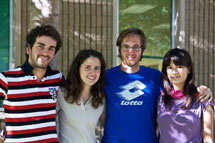
Handy Links
SLAC News Center
SLAC Today
- Subscribe
- Archives: Feb 2006-May 20, 2011
- Archives: May 23, 2011 and later
- Submit Feedback or Story Ideas
- About SLAC Today
SLAC News
Lab News
- Interactions
- Lightsources.org
- ILC NewsLine
- Int'l Science Grid This Week
- Fermilab Today
- Berkeley Lab News
- @brookhaven TODAY
- DOE Pulse
- CERN Courier
- DESY inForm
- US / LHC
SLAC Links
- Emergency
- Safety
- Policy Repository
- Site Entry Form

- Site Maps
- M & O Review
- Computing Status & Calendar
- SLAC Colloquium
- SLACspeak
- SLACspace
- SLAC Logo
- Café Menu
- Flea Market
- Web E-mail
- Marguerite Shuttle
- Discount Commuter Passes
-
Award Reporting Form
- SPIRES
- SciDoc
- Activity Groups
- Library
Stanford
Around the Bay
Italian Students Bid SLAC a Heartfelt "Ciao!"
Four Italian students have concluded their two-month stints here as SLAC researchers and are heading back to Italy and back to their universities. The students took part in a summer exchange program co-sponsored by the Department of Energy and the Italian National Institute for Nuclear Physics. SLAC has welcomed Italian exchange students for all of nine years of the program's existence, according to Steve Williams, original SLAC program liaison, and Harvey Lynch, who took over the position in 2006.
The students, one of whom arrived with a newly-minted laurea triennale (the Italian equivalent of a bachelor's degree), came from all over Italy—from Milan in the north to Bari in the south, Trieste to the east and Pisa to the west. They leave with valuable hands-on experience gained as members of the either the Fermi Gamma-ray Space Telescope or the BaBar team, data for their master's theses, and a sincere appreciation of the beauties of the Bay Area and beyond.
Mattia Sormani studied gamma-ray polarization under Fermi Telescope mentor Rolf Buehler, and worked on optimizing the detector software using ROOT, a software package for data handling that originated at the European Center for Nuclear Research. Sormani said he considered the experience valuable.
"I don't know if I'll work on the same experiment in future," Sormani said, "but ROOT and ROOT tools will be very useful."
Lucia Grillo analyzed data gathered by the Large Area Telescope, including data from gamma-ray bursts and from our own sun. She worked at "optimizing the cuts" with the goal of refining the data selection for low-energy data analysis under the supervision of mentor Nicola Omodei, of the Fermi telescope collaboration.
"Working with Nicola, I could see everything of the research," Grillo said. "The meetings, the politics…. I could see how research works. In Italy I've never had any chance like this."
"The preparation of these young students is very good, and this makes very pleasant and fruitful to work with them," said Omodei. Of his own charge, he commented, "Lucia in a very short time was able to present her results, and to give a talk in front of other people."
Chiara Piacentini performed data analysis under the supervision of mentor David Lopes Pegna of the BaBar collaboration, working to establish the propensity of subatomic particles called B mesons to undergo a process called semi-leptonic decay. Piacentini said she plans to take her work home to Italy with her.
"In my classes I'll continue this analysis," she said.
Leonardo Cristella looked for evidence of glueballs, or agglomerations of gluons, in BaBar data, under the supervision of mentor Bryan Fulsom.
"I liked working on a big experiment," Cristella said. The groundwork has been laid, he explained, and the data collected. "I could start to work immediately."
"Italian institutions in particular play an important role in the BaBar Collaboration and the proposal for a next generation Super B Factory," said Fulsom. "I think the summer program is a great way to recruit new students to this area of study, and to help us continue to produce even more physics results from the BaBar data."
The exchange program offered the Italian students learning opportunities inside and outside their research projects, including a chance to attend the SLAC Summer Institute.
"We met a lot of young people like us," Leonardo said of SSI. "It was an opportunity to ask others how they study." It was also an opportunity for Cristella to represent the Institute in the annual SLAC-SSI soccer match.
Since Bay Area traffic held no fears for them ("Here it's easy to drive," said Sormani) the students spent weekends playing tourist with trips to San Francisco, Yosemite National Park, Lake Tahoe, Santa Cruz and the Monterey Bay area, as well as further afield to Los Angeles and Los Vegas. One weekend was spent in Napa Valley.
As for Napa Valley wines? "There's a lot of choice," said Cristella diplomatically.
Sormani was a bit more forthcoming. "They're strong," he said.
The students said they did miss real Italian food, though they gained an appreciation for cheeseburgers with avocado and bacon.
"All students should take an opportunity like this," said Cristella. "It's very different from Italy." He paused. "Very, very, very different from Italy."
—Lori Ann White
SLAC Today, September 21, 2010
